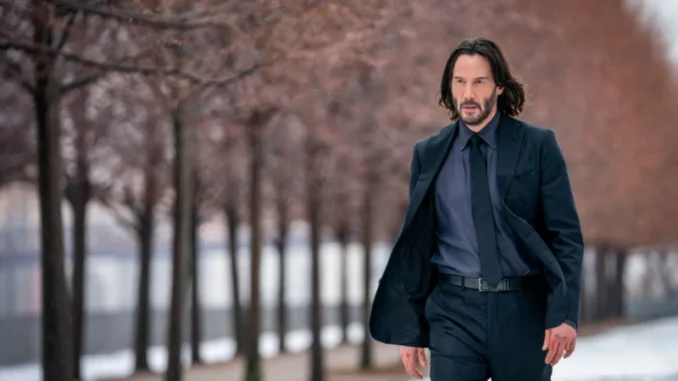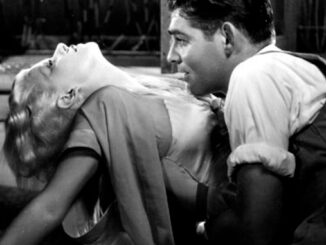
By Su Fang Tham
With its entrancing medley of neon-drenched kinetic action, pulpy narrative, and a retro-cool mythological world, director Chad Stahelski’s deliriously entertaining “John Wick” action franchise is back with its fourth installment. Once again, Keanu Reeves dons the bespoke bulletproof black suit to reprise the role of the titular assassin in “John Wick: Chapter 4,” fighting for his freedom — and ultimately, his life — from the oppressive rulers of the criminal underworld, The High Table.
Ending a caper that began when mindless thugs killed the posthumous gift (the cutest beagle puppy!) from his recently deceased wife days after the funeral, John’s latest globe-trotting trek reveals old friends from his past, including Osaka Continental boss, Koji Shimazu (Hiroyuki Sanada) and first-rate blind assassin, Caine (Donnie Yen). Franchise regulars Winston (Ian McShane), Charon (the late Lance Reddick), and The Bowery King (Lawrence Fishburne) also return to aid John one last time.
To capture all the action in-camera, Stahelski prefers wide shots and longer takes, allowing the fluid and intense action to unfold like a dance on stage. “Your camera is the best seat in the theater,” picture editor Nathan Orloff described the unique visual language. “On other films, you have more medium shots that need to be cut faster. But on ‘John Wick,’ we have wide shots from head-to-toe, and the camera is there to capture everything as the action plays out in real-time.”
Still reeling from his grief, John always finds a way to get back up after being shot at, kicked, slashed, choked, and even hurled off a building. In anchoring the emotional undercurrent of the revenge saga, Orloff honed in on his vulnerability. “The man’s exhausted! He wouldn’t even be around if Caine, Koji, and The Tracker (a bounty hunter played by Shamier Anderson) hadn’t saved him. The key to John Wick’s charm is that he isn’t perfect. He struggles in every fight and barely makes it out alive. Even though he ultimately survives, we still buy that he may not,” Orloff added.
The sonic landscape of any Wick film has to cover a much more expansive spectrum than most other action films to include: hand-to-hand combat interlaced with shoot-outs (gun-fu), high-octane car chases using vehicles as the weapon (car-fu), gunfights with dogs as the main ally (dog-fu), and other bone-crunching brawls with knives, nunchucks, swords – or even a belt or a leather-bound book (as we saw in the third installment).
It is up to Supervising Sound Editor Mark Stoeckinger — the Oscar-nominated veteran across all four Wick films —to come up with various ways to make each pistol, revolver, shotgun, silencer, or sniper rifle sound unique. “One gunshot could be made up of eight to 10 different sounds. They evolve over a string of shots, and when we mix it, we adjust each one. Maybe we need more low frequency here, add a subwoofer spike element, vary the compression or reverb, or incorporate the gun mechanism into it.”

Working with sound designer Alan Rankin, who has done all the gun work through all four films, the sound team meticulously constructs everything we hear and feel. “When John shoots the gun into the camera, it might be big and bassy. When he turns 90 degrees and shoots, it sounds different. We lean heavily into what the guns hit, like if it’s a ricochet. There’s always a cause and effect in everything,” Stoeckinger added.
The mind-blowing action isn’t there just for action’s sake. Instead, the meticulous choreography adds layers to the plot and texture to the characters. “The action beats are the story, they are dialogue, except with guns and Kung Fu. It’s conflict.” Which is why Orloff wants the action to be clear and crisp in every scene. “I want the audience to understand everything. There’s a narrative that isn’t just chaos. That is the most important thing in action sequences when it comes to editing.” He is relentless when trimming each scene, pushing and compressing until it is just right. “Any less and people would be confused, but any more, they would be bored.”
Both Stahelski and Reeves have often commented on how much they love it when John suffers, and Orloff agrees. “The more exhausted John is, the more we put him through, the more we empathize with him and find drama in his struggle.” Towards the end, after John has just fought off a phalanx of mercenaries in the middle of Paris, there is a viscerally painful but also comical sequence. In an homage to silent comedy icon Buston Keaton, John is tossed down the 222 steps of the famed Rue Foyatier on his way to the final showdown against the Marquis de Gramont (Bill Skarsgård) — The High Table’s latest emissary. Before he gets to the Sacré Cœur Basilica, John tumbles all the way down the steep staircase, not once, but twice.
“We always try to hurt him. So, we wanted to make it sound painful, because it is,” said Stoeckinger. “Between the Foley artists and Alan, we made sure that was an important aspect. The production sound from that scene was really good, so our dialogue editors were able to incorporate a lot of that. To accentuate what’s there but still make it sound as natural as possible, we peppered in group ADR recorded in a space that would sonically match where it was shot.”
‘We always try to hurt him. We wanted to make it sound painful.’
One of the most visually arresting sequences in “Chapter 4” is the doll’s house view tracking shot (also known as the “top shot”). After a new batch of the Marquis’ henchmen and freelance hitmen chase a bone-tired John into an abandoned building, the shoot-out erupts from room to room as the camera follows overhead. “It was only two stitches to combine three takes. More than anything, this was a dance. They had a counter so that everyone could hit their mark at precisely the right time. Like on 27, the stunt guy would jump into this hallway. And on 30, Keanu would know someone’s coming through that door.” To nail it all in one take, multiple elements had to move as one: Reeves, the stunt actors, and the Spidercam system suspended overhead.
“There is so much going on in that scene, so many shots with various weapons, all the bullets hitting everywhere, the dog jumping across the room then landing on the piano. The challenge was living up to that — because it’s so visually rich, you want it to be sonically rich as well, but without getting in the way,” Stoeckinger recalled of the jaw-dropping sequence, in which the viewers could sense the dangers that John is walking into before he does. “We put as much detail as possible without overdoing it, but still keep your focus on what we want you to notice. We don’t want to highlight something that you’re not supposed to be paying attention to. Your ears lead your eyes and vice versa,” he elaborated.

Stahelski designed this sequence to showcase the latest weapon in Wick-verse: the Dragon’s Breath Shotgun, which discharges phosphorous rounds that burst into flames and incinerate the enemy. “The coolest way to see the fire coming across the frame was from up top,” Orloff said. In coming up with how a phosphorous shotgun might sound best on screen, Stoeckinger looked at YouTube clips featuring a real specimen and noticed it has traces of a lion’s roar. “It also has kind of a flamethrower whoosh. Then, we added in the crackle of fireworks and the pop and crackle of a flashbulb.”
In the climactic set piece, John has to make it to the Sacré Cœur Basilica by sunrise for the duel against the Marquis, or risk forfeiture and immediate execution. On his way, he is met with an endless throng of thugs in a free-for-all in the traffic circle before the Arc de Triomphe. As he shoots and crashes his way through the pulse-pounding wrong-way speeding car chase/gunfight, we are treated to the pinnacle of car-fu and gun-fu combined to maximum effect.
For safety reasons, the sequence was not shot in the middle of Paris, but on the tarmac in an abandoned airport in Berlin, with triangular padded sleds with headlights standing in for most of the cars. “I had to imagine the geography of most of it,” Orloff revealed, adding that he had to edit this sequence before the digital cars and the Arc de Triomphe were layered in. “I would say one-fifth of the cars were real and the rest were these sleds, so all the hits are all real. It was so bananas to edit. This is the one that I’m most proud of in the movie; it was the most difficult to cut but also the most satisfying.”
When it came to layering in sound, it was a painstaking process that lasted for weeks. “The more detail and texture we added to it, the more we could tell what else was missing. It took five of us taking different passes at it to try to make it dense and chaotic, with the cars and horns, the skidding of the cars in traffic, and the Tracker’s dog amidst the shoot-out,” added Stoeckinger.
When John finally gets to the duel, he has to go up against a very reluctant Caine, who is forced to stand in as the Marquis’ proxy to keep his daughter alive. “I’m glad Caine brought humor to this scene [when he tells the Marquis to ‘F*ck off!’]. I’m a big fan of oscillating tones, which is sometimes weird and difficult. But I think if you laugh, then we can go back to being dramatic. I love taking the audience on that roller coaster.”
Already the biggest box-office success in the franchise’s history, with more than $430 million worldwide — and the best-reviewed film in the franchise, with a 96% Tomatometer score — “John Wick: Chapter 4” bids adieu leaving its fans wanting more. In a franchise-fatigued cinematic landscape, this is the highest possible compliment that any filmmaker could ask for.






